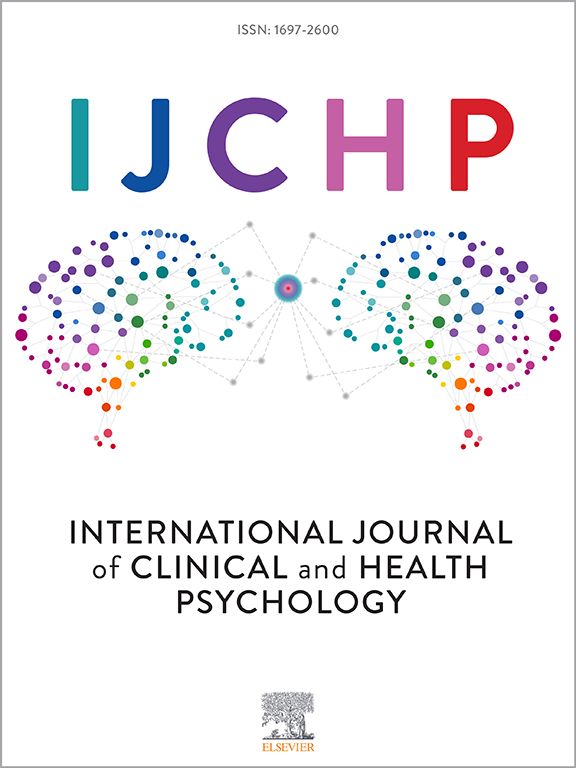Physical performance, health-related quality of life and sleepiness severity of an adult outpatient population with narcolepsy: A cross-sectional analysis
IF 4.4
1区 心理学
Q1 PSYCHOLOGY, CLINICAL
International Journal of Clinical and Health Psychology
Pub Date : 2025-04-01
DOI:10.1016/j.ijchp.2025.100573
引用次数: 0
Abstract
Objectives
This study aimed to profile and explore the correlation between health-related quality of life (HRQoL), sleepiness severity and physical performance in a sample of people with narcolepsy type 1 (NT1).
Methods
This cross-sectional study took place in a dedicated outpatient narcolepsy clinic. The following variables were evaluated: cardiopulmonary fitness, physical activity, muscle strength, muscle endurance, power. HRQoL was assessed using the Short Form-36 (SF-36) and the Functional Outcome of Sleep Questionnaire (FOSQ). Sleepiness Severity was measured by the Epworth Sleepiness Scale (ESS), and symptom severity was assessed using the Narcolepsy Severity Scale (NSS).
Results
A total of 22 participants (31.53 ± 13.17 years, 56.52 % female) completed the test battery. Physical performance was low across all measures. With the exception of accelerometery (54.17 % compliance), there was full compliance (100 %) with the test battery, indicating its feasibility for people with narcolepsy. Results showed that physical performance and HRQoL were markedly reduced compared to normative values in this sample of people with narcolepsy. Self-reported physical activity was associated with higher health-related quality of life (ρ = 0.41; p = 0.05), and greater moderate-vigorous physical activity was associated with higher physical wellbeing (ρ = 0.58; p = 0.04). Higher BMI was associated with significantly lower predicted VO₂ Max (0.001), and wall sit duration (p = 0.039).
Conclusion
The influence of physical performance on sleepiness severity and quality of life warrants further investigation, including the possible physical rehabilitation strategies to target physical performance deficits.
门诊成人发作性睡症患者的身体表现、健康相关生活质量和嗜睡严重程度:一项横断面分析
本研究旨在分析和探讨1型发作性睡病(NT1)患者的健康相关生活质量(HRQoL)、嗜睡严重程度和身体表现之间的相关性。方法本横断面研究在一家专门的发作性睡病门诊进行。评估了以下变量:心肺健康、体力活动、肌肉力量、肌肉耐力、力量。HRQoL采用短表36 (SF-36)和睡眠功能结局问卷(FOSQ)进行评估。采用Epworth嗜睡量表(ESS)测量嗜睡严重程度,采用嗜睡严重程度量表(NSS)评估症状严重程度。结果共22名参与者(31.53±13.17岁,女性56.52%)完成了测试。体能表现在所有指标中都很低。除了加速计测试(54.17%)外,测试电池完全符合(100%),表明其适用于嗜睡症患者。结果显示,与正常值相比,嗜睡症患者的身体表现和HRQoL明显降低。自我报告的体力活动与较高的健康相关生活质量相关(ρ = 0.41;P = 0.05),较高的中高强度体力活动与较高的身体健康相关(ρ = 0.58;P = 0.04)。BMI越高,预测vo2max(0.001)和坐壁时间越低(p = 0.039)。结论体能表现对嗜睡严重程度和生活质量的影响值得进一步研究,包括针对体能表现缺陷的可能的体能康复策略。
本文章由计算机程序翻译,如有差异,请以英文原文为准。
求助全文
约1分钟内获得全文
求助全文
来源期刊

International Journal of Clinical and Health Psychology
PSYCHOLOGY, CLINICAL-
CiteScore
10.70
自引率
5.70%
发文量
38
审稿时长
33 days
期刊介绍:
The International Journal of Clinical and Health Psychology is dedicated to publishing manuscripts with a strong emphasis on both basic and applied research, encompassing experimental, clinical, and theoretical contributions that advance the fields of Clinical and Health Psychology. With a focus on four core domains—clinical psychology and psychotherapy, psychopathology, health psychology, and clinical neurosciences—the IJCHP seeks to provide a comprehensive platform for scholarly discourse and innovation. The journal accepts Original Articles (empirical studies) and Review Articles. Manuscripts submitted to IJCHP should be original and not previously published or under consideration elsewhere. All signing authors must unanimously agree on the submitted version of the manuscript. By submitting their work, authors agree to transfer their copyrights to the Journal for the duration of the editorial process.
 求助内容:
求助内容: 应助结果提醒方式:
应助结果提醒方式:


